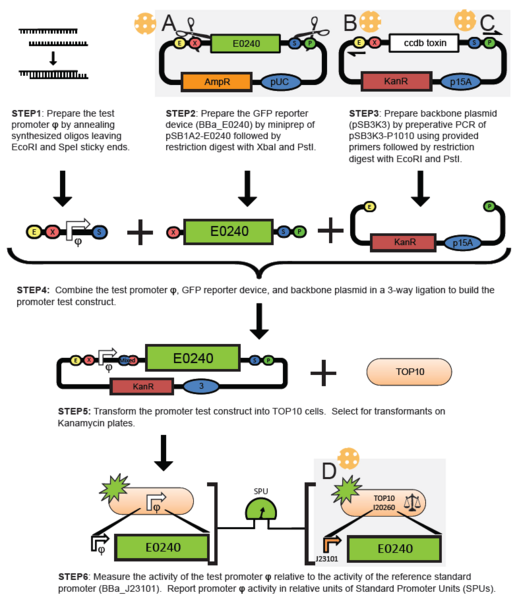Team:KULeuven/Wetlab/Blue Light Receptor
From 2009.igem.org
(→Where from) |
(→Steps) |
||
| Line 22: | Line 22: | ||
==Steps== | ==Steps== | ||
| - | #PCR reaction to | + | #PCR reaction to multiply the promotor DNA. |
| - | # | + | #Since our primers contained the correct pre-and suffixes, we can just cut with EcoRI and SpeI. |
| - | #Cut GFP with EcoRI and XbaI. | + | #Cut GFP with EcoRI and XbaI. Insert the restricted promotor fragment in front of the GFP in the high copy vector. |
| - | + | #When this worked, cut the promotor+GFP insert out with EcorRI and PstI and ligate this in the low copy vectors needed for testing. | |
| - | # | + | |
| - | + | ||
| - | + | ||
| - | + | ||
| + | ;Testing of the promotor is done in two ways | ||
| + | :- comparing the activity of the promotor to a standard promotor (see image) | ||
[[Image:515px-Promoter_Instructions_Build.png|center|thumb|600px|standard promotor test]] | [[Image:515px-Promoter_Instructions_Build.png|center|thumb|600px|standard promotor test]] | ||
| + | |||
| + | :-checking how the promotor responds to blue light | ||
| + | |||
| + | Electrocompetent Top10 cells were electroporated with K238015, K238013 in psB3K3, I20260 and empty Top10 cells. These cells were plated out on agar plates with the correct AntiBiotic and grown overnight (37°). From these, a 5ml liquid culture supplied with AB was prepared and also grown overnight (37°C or 25°C). These cells were inoculated in fresh LB medium (100 µg AB/ ml) in the morning and grown at 16°C or 25°C for 3.5h. During all these steps, the cells were always kept away in the dark. Only when the experiment started, half of the cultures were put under blue light, the other half were kept in the dark. After that, the cells were whithdrawn at different time intervals. They were diluted into PBS and analyzed by flow cytometry with a Becton Dickinson FACSCalibur and CELLQuestTM acquisition and analysis software with gates set to forward and side scatters characteristic of the bacteria (Gate G2=R2). We decided upon using FACS because then the fluorescence of single cells is measured. Since each time the fluorescence of 10,000 individual cells is measured, FACS allows more elaborate and accurate statistical analysis. | ||
==Important== | ==Important== | ||
Revision as of 15:46, 20 October 2009
Blue Light Receptor: Planning
Goal
Purifying the promoter region of the blue light receptor from E. Coli. This promotor region than has to be ligated in test-plasmids with GFP or RFP to see how well our promotor responds to blue light.
Required
- E.Coli strain ( MC4100)
- Primers (1) for PCR: already ordered (nummers: 2171 (FP) - 2172 (RP))
- GFP with RBS and Terminator sequence
- Reference plasmids so we can check the strength of the promotor.
Where from
- Strain: from lab
- Primers: self made and ordered
- For PCR
- Forward: CATCAT GAATTCGCGGCCGCTTCTAGAG TTT GAC AGG TTC GTC GTC
- Reverse: CTGCAGCGGCCGCTACTAGTA CCT CTG TTA AAA ATG TTA ATC AAT GTT AAG
- For PCR
- The GFP () came from the freezer (-80) at the lab
Steps
- PCR reaction to multiply the promotor DNA.
- Since our primers contained the correct pre-and suffixes, we can just cut with EcoRI and SpeI.
- Cut GFP with EcoRI and XbaI. Insert the restricted promotor fragment in front of the GFP in the high copy vector.
- When this worked, cut the promotor+GFP insert out with EcorRI and PstI and ligate this in the low copy vectors needed for testing.
- Testing of the promotor is done in two ways
- - comparing the activity of the promotor to a standard promotor (see image)
- -checking how the promotor responds to blue light
Electrocompetent Top10 cells were electroporated with K238015, K238013 in psB3K3, I20260 and empty Top10 cells. These cells were plated out on agar plates with the correct AntiBiotic and grown overnight (37°). From these, a 5ml liquid culture supplied with AB was prepared and also grown overnight (37°C or 25°C). These cells were inoculated in fresh LB medium (100 µg AB/ ml) in the morning and grown at 16°C or 25°C for 3.5h. During all these steps, the cells were always kept away in the dark. Only when the experiment started, half of the cultures were put under blue light, the other half were kept in the dark. After that, the cells were whithdrawn at different time intervals. They were diluted into PBS and analyzed by flow cytometry with a Becton Dickinson FACSCalibur and CELLQuestTM acquisition and analysis software with gates set to forward and side scatters characteristic of the bacteria (Gate G2=R2). We decided upon using FACS because then the fluorescence of single cells is measured. Since each time the fluorescence of 10,000 individual cells is measured, FACS allows more elaborate and accurate statistical analysis.
Important
Following conditions need to be taken into account:
- For growth of the bacteria: 37°C
- For expression of the genes regulated by ycgF/E system: 16°C
- At 16°C: expression will start after 50h and a very slow reversion to the ground state of ycgF
- Working with a colony in the dark and one in light so that the effects of cold temperature on the gene expression pattern can be calculated out.
- Blue light does NOT induce stress and cell death in E. Coli
- To monitor growth of the cells, measurement at OD 578 can be used
 "
"








